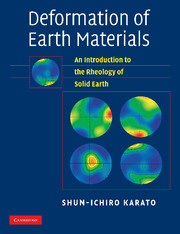Book contents
- Frontmatter
- Contents
- Preface
- Part I General background
- Part II Materials science of deformation
- Part III Geological and geophysical applications
- 17 Composition and structure of Earth's interior
- 18 Inference of rheological structure of Earth from time-dependent deformation
- 19 Inference of rheological structure of Earth from mineral physics
- 20 Heterogeneity of Earth structure and its geodynamic implications
- 21 Seismic anisotropy and its geodynamic implications
- References
- Materials index
- Subject index
- Plate section
18 - Inference of rheological structure of Earth from time-dependent deformation
Published online by Cambridge University Press: 05 June 2012
- Frontmatter
- Contents
- Preface
- Part I General background
- Part II Materials science of deformation
- Part III Geological and geophysical applications
- 17 Composition and structure of Earth's interior
- 18 Inference of rheological structure of Earth from time-dependent deformation
- 19 Inference of rheological structure of Earth from mineral physics
- 20 Heterogeneity of Earth structure and its geodynamic implications
- 21 Seismic anisotropy and its geodynamic implications
- References
- Materials index
- Subject index
- Plate section
Summary
Deformation of Earth can occur with a range of time-scales including attenuation of seismic waves (at a time-scale of ~1–103 s), post-glacial crustal rebound (~1010–1011 s), and deformation associated with mantle convection (~1014–1015 s). Theoretical analyses of observations on these processes of time-dependent deformation provide us with clues as to the non-elastic properties of Earth's interior. However, the time-scales, and hence the strain (and stress) magnitude involved in these processes are different, and therefore microscopic mechanisms can be different among the deformation involved in these processes. A brief review is presented on the essence of these processes including the nature of deformation and the methods of studying them, in addition to some of the representative results.
Key words seismic wave attenuation, Q, post-glacial rebound, relative sea level, geoid, dynamic topography, isostasy.
Time-dependent deformation and rheology of Earth's interior
Observations on time-dependent deformation of Earth provide important constraints on the rheological properties of Earth's interior. Time-dependent deformation of Earth can be directly observed from seismic or geodetic measurements or indirectly from gravity measurements. These phenomena have different time-scales and different strain (stress) amplitude. Consequently, different physical processes may operate for different time-dependent deformation processes.
For seismic wave attenuation (or Chandler wobble), deformation occurs at short time-scales (1–103 s for seismic waves, ~107 s for Chandler wobble), low stress level (< 103 Pa), so deformation is linear but strain involved is small (~10− 6− 10− 8). The distribution of non-elastic properties for this time-scale is well determined mostly from seismological observations.
- Type
- Chapter
- Information
- Deformation of Earth MaterialsAn Introduction to the Rheology of Solid Earth, pp. 323 - 337Publisher: Cambridge University PressPrint publication year: 2008



